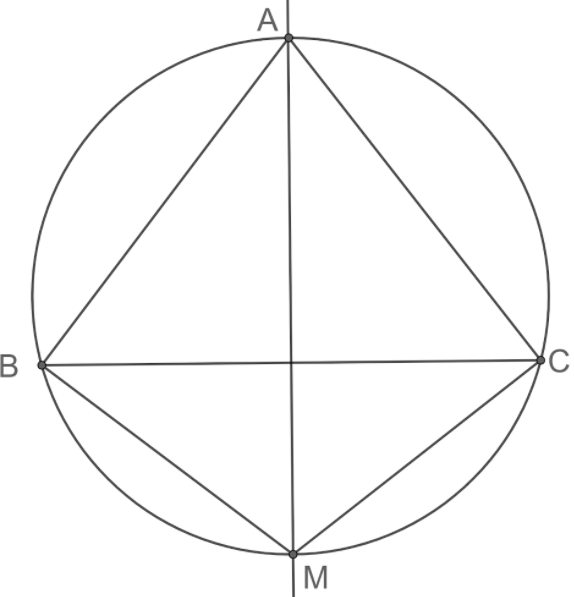
‘I’ is the perpendicular bisector of side BC of
(a)
(b)
(c)
(d)
Answer
484.2k+ views
Hint: We start solving the problem by drawing the figure representing the given information. We then use the property that an arc in a circle subtends equal angles anywhere on the circumference. We then check whether both angles given in each option are satisfying this property to get the correct option.
Complete step-by-step solution:
Let us draw the figure representing the given information.

From the property of angle subtended by an arc, we know that an arc in a circle subtends equal angles anywhere on the circumference.
In this figure, BM is the chord.
Hence, by this property,
Hence, option (b) is correct.
Now, we will start checking other options.
(A)
Here, look at the angles
For the property to get applied, the angles should be subtended at the same arc.
Therefore, option (A) is incorrect.
(C)
Here, look at the angles
For the property to get applied, the angles should be subtended at the same arc.
Therefore, option (C) is incorrect.
(D)
Here, look at the angles
For the property to get applied, the angles should be subtended at the same arc.
Therefore, option (D) is incorrect.
Hence option B is the correct answer
Note: We can also find all the angles required by assuming one angle in the triangle and finding the other angles. We can see that the triangle ABC is an isosceles triangle with equal sides AB and AC. We can use the fact that the angles to equal sides in a triangle are equal and the sum of the angles in a triangle is
Complete step-by-step solution:
Let us draw the figure representing the given information.

From the property of angle subtended by an arc, we know that an arc in a circle subtends equal angles anywhere on the circumference.
In this figure, BM is the chord.
Hence, by this property,
Hence, option (b) is correct.
Now, we will start checking other options.
(A)
Here, look at the angles
For the property to get applied, the angles should be subtended at the same arc.
Therefore, option (A) is incorrect.
(C)
Here, look at the angles
For the property to get applied, the angles should be subtended at the same arc.
Therefore, option (C) is incorrect.
(D)
Here, look at the angles
For the property to get applied, the angles should be subtended at the same arc.
Therefore, option (D) is incorrect.
Hence option B is the correct answer
Note: We can also find all the angles required by assuming one angle in the triangle and finding the other angles. We can see that the triangle ABC is an isosceles triangle with equal sides AB and AC. We can use the fact that the angles to equal sides in a triangle are equal and the sum of the angles in a triangle is
Recently Updated Pages
Express the following as a fraction and simplify a class 7 maths CBSE

The length and width of a rectangle are in ratio of class 7 maths CBSE

The ratio of the income to the expenditure of a family class 7 maths CBSE

How do you write 025 million in scientific notatio class 7 maths CBSE

How do you convert 295 meters per second to kilometers class 7 maths CBSE

Write the following in Roman numerals 25819 class 7 maths CBSE

Trending doubts
A boat goes 24 km upstream and 28 km downstream in class 10 maths CBSE

The British separated Burma Myanmar from India in 1935 class 10 social science CBSE

The Equation xxx + 2 is Satisfied when x is Equal to Class 10 Maths

What are the public facilities provided by the government? Also explain each facility

Difference between mass and weight class 10 physics CBSE

SI unit of electrical energy is A Joule B Kilowatt class 10 physics CBSE




